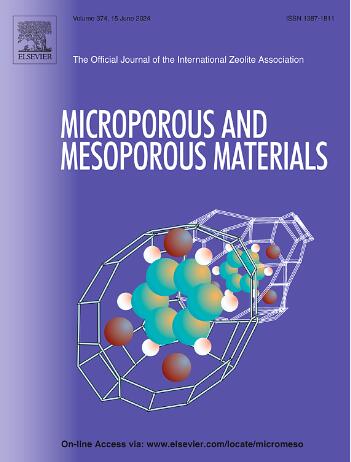Enhanced ion pairing of calcium, zinc, and lanthanum with acetate in silica nanopores
IF 4.8
3区 材料科学
Q1 CHEMISTRY, APPLIED
引用次数: 0
Abstract
The well-established intrinsic properties and reactivity of molecules in aqueous environments are influenced when confined in pores, cages, channels, or slits. Nanoconfined chemical systems are common in the environment, such as in soils and sedimentary rocks. In this study, the impact of nanoscale confinement on the ion pairing involving Ca2+, Zn2+, and La3+ with CH3COO− anions was investigated. The concentrations of free (uncomplexed) CH3COO− and the Mn+–CH3COO− species (acetate complexed with a cation, M = Ca2+, Zn2+, or La3+) were quantified using Raman spectroscopy performed on bulk aqueous solutions and on the same solutions confined within 4 nm amorphous silica nanopores. The calculated equilibrium constants increased by 0.09, 1.70, and 2.5 units for Ca2+–, Zn2+–, and La3+–CH3COO−, respectively, when compared to analogous constants measured for bulk solutions. These shifts in the equilibrium constants correspond to the free energy of formation of contact ion pairs in confinement becoming more favorable by 0.11, 0.77, and 0.40 kJ⸳mol−1 compared to bulk solution phase. In support of the experimental findings, molecular dynamics and density functional theory calculations predict the stabilization of contact ion pairs in confined systems compared to bulk aqueous environment. The observed increase in the equilibrium constants of contact ion pairing is attributed to the lower desolvation cost in the silica nanopore compared to unconfined aqueous solution.

求助全文
约1分钟内获得全文
求助全文
来源期刊

Microporous and Mesoporous Materials
化学-材料科学:综合
CiteScore
10.70
自引率
5.80%
发文量
649
审稿时长
26 days
期刊介绍:
Microporous and Mesoporous Materials covers novel and significant aspects of porous solids classified as either microporous (pore size up to 2 nm) or mesoporous (pore size 2 to 50 nm). The porosity should have a specific impact on the material properties or application. Typical examples are zeolites and zeolite-like materials, pillared materials, clathrasils and clathrates, carbon molecular sieves, ordered mesoporous materials, organic/inorganic porous hybrid materials, or porous metal oxides. Both natural and synthetic porous materials are within the scope of the journal.
Topics which are particularly of interest include:
All aspects of natural microporous and mesoporous solids
The synthesis of crystalline or amorphous porous materials
The physico-chemical characterization of microporous and mesoporous solids, especially spectroscopic and microscopic
The modification of microporous and mesoporous solids, for example by ion exchange or solid-state reactions
All topics related to diffusion of mobile species in the pores of microporous and mesoporous materials
Adsorption (and other separation techniques) using microporous or mesoporous adsorbents
Catalysis by microporous and mesoporous materials
Host/guest interactions
Theoretical chemistry and modelling of host/guest interactions
All topics related to the application of microporous and mesoporous materials in industrial catalysis, separation technology, environmental protection, electrochemistry, membranes, sensors, optical devices, etc.
 求助内容:
求助内容: 应助结果提醒方式:
应助结果提醒方式:


